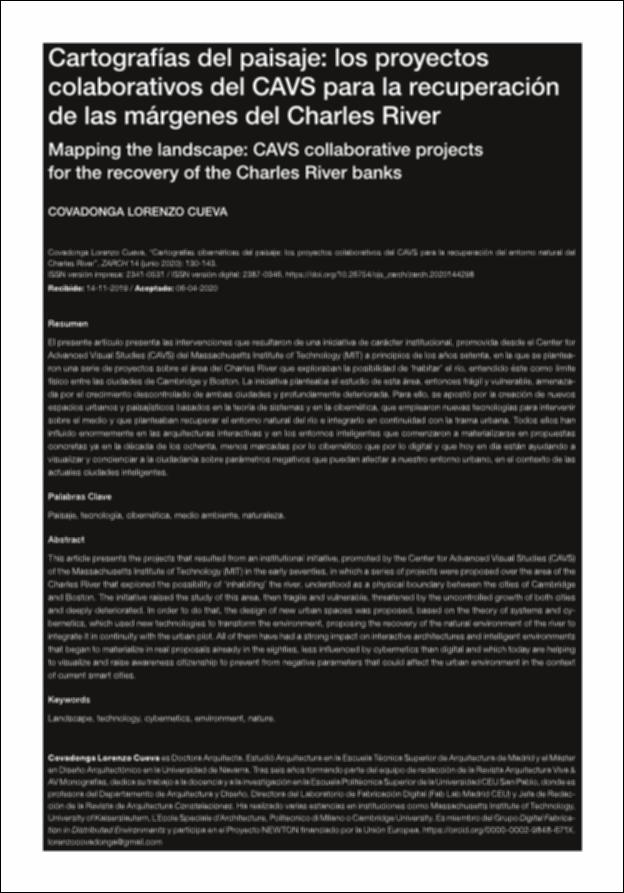Por favor, use este identificador para citar o enlazar este ítem:
http://hdl.handle.net/10637/15633Cartografías del paisaje: los proyectos colaborativos del CAVS para la recuperación de las márgenes del Charles River
| Título : | Cartografías del paisaje: los proyectos colaborativos del CAVS para la recuperación de las márgenes del Charles River Mapping the landscape: CAVS collaborative projects for the recovery of the Charles River banks |
| Autor : | Lorenzo Cueva, Covadonga |
| Materias: | Paisaje; Tecnología; Cibernética; Medio ambiente; Naturaleza; Landscape; Technology; Cybernetics; Environment; Nature |
| Editorial : | Universidad de Zaragoza: Departamento de Arquitectura |
| Citación : | Lorenzo, C. (2020). Cartografías cibernéticas del paisaje: los proyectos colaborativos del CAVS para la recuperación del entorno natural del Charles River. ZARCH, (14), 130–143. https://doi.org/10.26754/ojs_zarch/zarch.2020144298 |
| Resumen : | El presente artículo presenta las intervenciones que resultaron de una iniciativa de carácter institucional, promovida desde el Center for
Advanced Visual Studies (CAVS) del Massachusetts Institute of Technology (MIT) a principios de los años setenta, en la que se plantearon
una serie de proyectos sobre el área del Charles River que exploraban la posibilidad de ‘habitar’ el río, entendido éste como límite
físico entre las ciudades de Cambridge y Boston. La iniciativa planteaba el estudio de esta área, entonces frágil y vulnerable, amenazada
por el crecimiento descontrolado de ambas ciudades y profundamente deteriorada. Para ello, se apostó por la creación de nuevos
espacios urbanos y paisajísticos basados en la teoría de sistemas y en la cibernética, que emplearon nuevas tecnologías para intervenir
sobre el medio y que planteaban recuperar el entorno natural del río e integrarlo en continuidad con la trama urbana. Todos ellos han
influido enormemente en las arquitecturas interactivas y en los entornos inteligentes que comenzaron a materializarse en propuestas
concretas ya en la década de los ochenta, menos marcadas por lo cibernético que por lo digital y que hoy en día están ayudando a
visualizar y concienciar a la ciudadanía sobre parámetros negativos que puedan afectar a nuestro entorno urbano, en el contexto de las
actuales ciudades inteligentes. This article presents the projects that resulted from an institutional initiative, promoted by the Center for Advanced Visual Studies (CAVS) of the Massachusetts Institute of Technology (MIT) in the early seventies, in which a series of projects were proposed over the area of the Charles River that explored the possibility of ‘inhabiting’ the river, understood as a physical boundary between the cities of Cambridge and Boston. The initiative raised the study of this area, then fragile and vulnerable, threatened by the uncontrolled growth of both cities and deeply deteriorated. In order to do that, the design of new urban spaces was proposed, based on the theory of systems and cybernetics, which used new technologies to transform the environment, proposing the recovery of the natural environment of the river to integrate it in continuity with the urban plot. All of them have had a strong impact on interactive architectures and intelligent environments that began to materialize in real proposals already in the eighties, less influenced by cybernetics than digital and which today are helping to visualize and raise awareness citizenship to prevent from negative parameters that could affect the urban environment in the context of current smart cities. |
| URI : | http://hdl.handle.net/10637/15633 |
| Derechos: | http://creativecommons.org/licenses/by-nc-nd/4.0/deed.es OpenAccess |
| ISSN : | 2387-0346 |
| Fecha de publicación : | 14-jun-2020 |
| Aparece en las colecciones: | Escuela de Politécnica Superior |
Los ítems de DSpace están protegidos por copyright, con todos los derechos reservados, a menos que se indique lo contrario.


